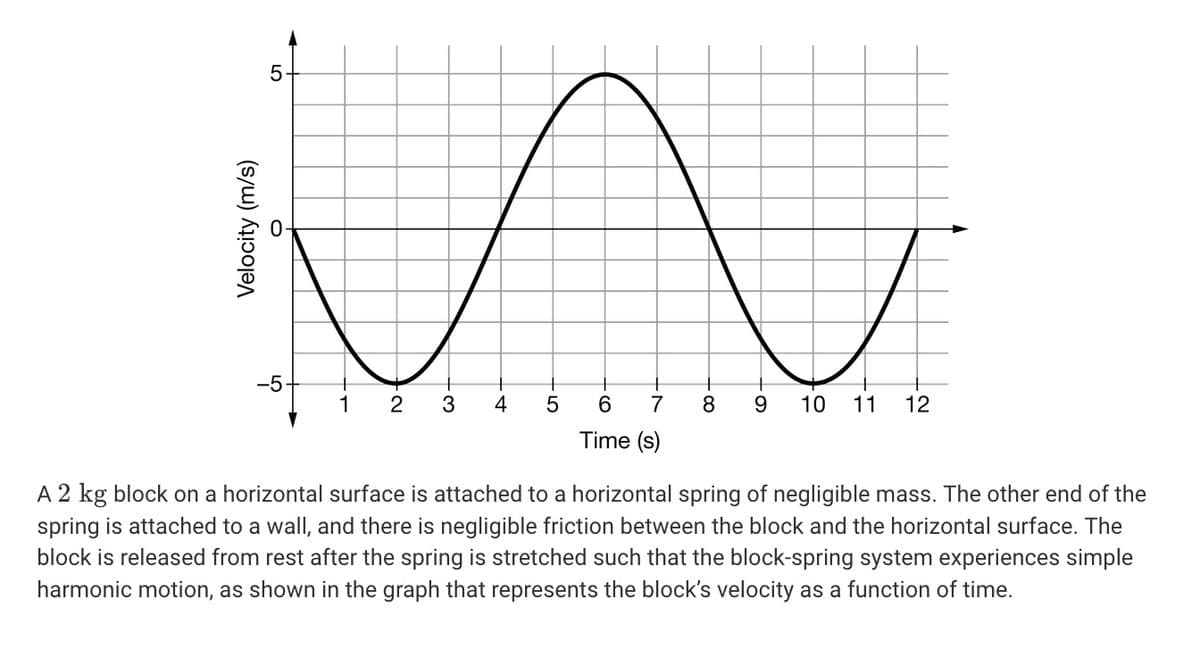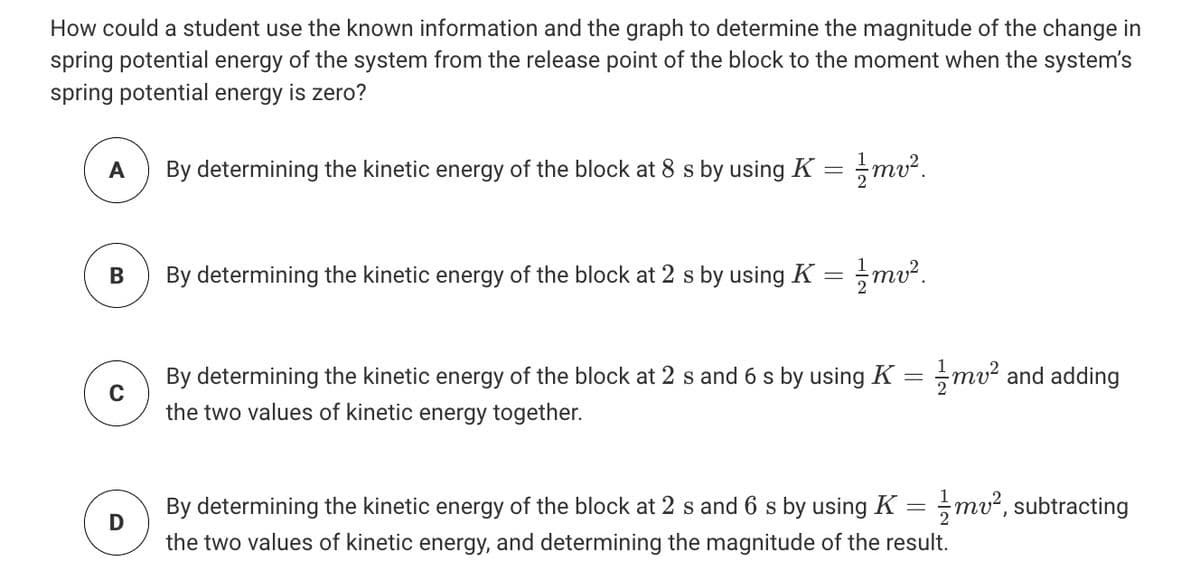A 2 kg block on a horizontal surface is attached to a horizontal spring of negligible mass. The other end of the spring is attached to a wall, and there is negligible friction between the block and the horizontal surface. The block is released from rest after the spring is stretched such that the block-spring system experiences simple harmonic motion, as shown in the graph that represents the block's velocity as a function of time.
A 2 kg block on a horizontal surface is attached to a horizontal spring of negligible mass. The other end of the spring is attached to a wall, and there is negligible friction between the block and the horizontal surface. The block is released from rest after the spring is stretched such that the block-spring system experiences simple harmonic motion, as shown in the graph that represents the block's velocity as a function of time.
Principles of Physics: A Calculus-Based Text
5th Edition
ISBN:9781133104261
Author:Raymond A. Serway, John W. Jewett
Publisher:Raymond A. Serway, John W. Jewett
Chapter7: Conservation Of Energy
Section: Chapter Questions
Problem 15P: A block of mass m = 2.00 kg is attached to a spring of force constant k = 500 N/m as shown in Figure...
Related questions
Question
Multiple Choice Question 7

Transcribed Image Text:-5
1
2 3
4
5
6.
7
8
10
11
12
Time (s)
A 2 kg block on a horizontal surface is attached to a horizontal spring of negligible mass. The other end of the
spring is attached to a wall, and there is negligible friction between the block and the horizontal surface. The
block is released from rest after the spring is stretched such that the block-spring system experiences simple
harmonic motion, as shown in the graph that represents the block's velocity as a function of time.
LO
Velocity (m/s)

Transcribed Image Text:How could a student use the known information and the graph to determine the magnitude of the change in
spring potential energy of the system from the release point of the block to the moment when the system's
spring potential energy is zero?
A
By determining the kinetic energy of the block at 8 s by using K
By determining the kinetic energy of the block at 2 s by using K =
By determining the kinetic energy of the block at 2 s and 6 s by using K
mv and adding
the two values of kinetic energy together.
By determining the kinetic energy of the block at 2 s and 6 s by using K
D
mv?, subtracting
the two values of kinetic energy, and determining the magnitude of the result.
Expert Solution
This question has been solved!
Explore an expertly crafted, step-by-step solution for a thorough understanding of key concepts.
This is a popular solution!
Trending now
This is a popular solution!
Step by step
Solved in 2 steps

Knowledge Booster
Learn more about
Need a deep-dive on the concept behind this application? Look no further. Learn more about this topic, physics and related others by exploring similar questions and additional content below.Recommended textbooks for you

Principles of Physics: A Calculus-Based Text
Physics
ISBN:
9781133104261
Author:
Raymond A. Serway, John W. Jewett
Publisher:
Cengage Learning

Physics for Scientists and Engineers with Modern …
Physics
ISBN:
9781337553292
Author:
Raymond A. Serway, John W. Jewett
Publisher:
Cengage Learning

College Physics
Physics
ISBN:
9781285737027
Author:
Raymond A. Serway, Chris Vuille
Publisher:
Cengage Learning

Principles of Physics: A Calculus-Based Text
Physics
ISBN:
9781133104261
Author:
Raymond A. Serway, John W. Jewett
Publisher:
Cengage Learning

Physics for Scientists and Engineers with Modern …
Physics
ISBN:
9781337553292
Author:
Raymond A. Serway, John W. Jewett
Publisher:
Cengage Learning

College Physics
Physics
ISBN:
9781285737027
Author:
Raymond A. Serway, Chris Vuille
Publisher:
Cengage Learning

College Physics
Physics
ISBN:
9781305952300
Author:
Raymond A. Serway, Chris Vuille
Publisher:
Cengage Learning

Physics for Scientists and Engineers, Technology …
Physics
ISBN:
9781305116399
Author:
Raymond A. Serway, John W. Jewett
Publisher:
Cengage Learning

Physics for Scientists and Engineers
Physics
ISBN:
9781337553278
Author:
Raymond A. Serway, John W. Jewett
Publisher:
Cengage Learning